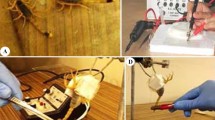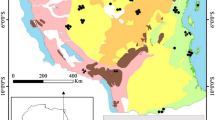Abstract
Bees are one of the ancient and the most social insects worldwide. They are of great economic and medical importance. Bee venom (BV) has many therapeutic effects and has been used since ancient times for the treatment of many diseases. The present study aimed to evaluate and compare the antibacterial effect of BV from two different bee subspecies Apis mellifera yemenitica (A. m. yemenitica) (indigenous strain) and Apis mellifera carnica (A. m. carnica) (carniolan strain) against selected Gram-positive and Gram-negative bacteria. Experimentally, venoms were extracted using an electrical venom collector from honey bee colonies of the subspecies, A. m. yemenitica and A. m. carnica, in Hail, Saudi Arabia. Each venom was tested against selected medically important Gram-negative strains, Salmonella Typhimurium, Pseudomonas aeruginosa, and Escherichia coli, while Staphylococcus aureus was selected as Gram-positive test organism. The minimum inhibitory concentration (MIC) method was used to compare the effect of BV from the two subspecies on the growth of the selected bacterial strains. Results showed that BV from both subspecies could equally inhibit the growth of Salmonella Typhimurium, Pseudomonas aeruginosa, and Escherichia coli at an MIC of 10 mg/ml. However, S. aureus was inhibited by an MIC of 5 and 10 mg/ml of BV from A. m. carnica and A. m. yemenitica, respectively. This suggested that the BV of the carnica subspecie was more inhibitory to this Gram-positive pathogen than its counterpart produced by the yemenitica subspecies. The present study shows that bee venom has a promising antibacterial effect.


Similar content being viewed by others
Data Availability
All relevant data are within the paper.
Change history
18 March 2022
A Correction to this paper has been published: https://doi.org/10.1007/s42770-022-00732-2
References
Al-Ghamdi A, Nuru A (2013) Beekeeping in the Kingdom of Saudi Arabia past and present practices. Bee World 90(2):26–29
Franck P, Garnery L, Loiseau A, Oldroyd BP, Hepburn HR, Solignac M, Cornuet JM (2001) Genetic diversity of the honeybee in Africa: microsatellite and mitochondrial data. Heredity 86(4):420–430
Alqarni AS, Hannan MA, Owayss AA, Engel MS (2011) The indigenous honey bees of Saudi Arabia (Hymenoptera, Apidae, Apis mellifera jemenitica Ruttner): their natural history and role in beekeeping. ZooKeys 134:83
Crane E (1983) Archaeology of beekeeping. Gerald Duckworth & Co Ltd, London
Charles KF, Michener D (2000) The bees of the world.–Baltimore and London (The John Hopkins University Press).–913 S., 48 Farbfotos und zahlr. s/w Illustrationen. ISBN 0‐8018‐6133‐0 (hardcover). US $165.–. Zoosyst Evol 78(2):353
Cridland JM, Tsutsui ND, Ramírez SR (2017) The complex demographic history and evolutionary origin of the western honey bee, Apis mellifera. Genome Biol Evol 9(2):457–472
Nordqvist J. Everything you need to know about honey. Medical News Today. https://www.medicalnewstoday.com/articles/264667.php (accessed 14 February 2018)
Kim MH (1992) Bee venom therapy and bee acupuncture therapy. Korean Education and Planning Co., Seoul, pp 67–182
Leluk J, Schmidt J, Jones D (1989) Comparative studies on the protein composition of hymenopteran venom reservoirs. Toxicon 27(1):105–114
Kokot ZJ, Matysiak J, Kłs J, Kędzia B, Hołderna-Kędzia E (2009) Application of Principal Component Analysis for evaluation of chemical and antimicrobial properties of honey bee (Apis mellifera) venom. J Apic Res 48(3):168–175
Fennell JF, Shipman WH, Cole LJ (1968) Antibacterial action of melittin, a polypeptide from bee venom. Proc Soc Exp Biol Med 127(3):707–710
Kokot ZJ, Matysiak J (2009) Simultaneous determination of major constituents of honeybee venom by LC-DAD. Chromatographia 69(11–12):1401–1405
Hossen M, Shapla UM, Gan SH, Khalil M (2017) Impact of bee venom enzymes on diseases and immune responses. Molecules 22(1):25
Komi DE, Shafaghat F, Zwiener RD (2018) Immunology of bee venom. Clin Rev Allergy Immunol 54(3):386–396
Zolfagharian H, Mohajeri M, Babaie M (2016) Bee venom (Apis Mellifera) an effective potential alternative to gentamicin for specific bacteria strains: bee venom an effective potential for bacteria. J Pharmacopunct 19(3):225
Yin C, Park HJ, Chae Y, Ha E, Park HK, Lee HS, Koh H, Kang S, Choi S, Ryu Y, Lee H (2007) Korean acupuncture: the individualized and practical acupuncture. Neurol Res 29(sup1):10–15
Ratcliffe N, Azambuja P, Mello CB (2014) Recent advances in developing insect natural products as potential modern day medicines. Evid Based Complement Alternat Med 2014
Curicio-Vonlanthen V, Schneider CH, Frutig K, Blaser K, Kalabacher H (1997) Molecular parameters in melittin immunogenicity. J Pept Sci 3(4):267–276
Socarras KM, Theophilus PA, Torres JP, Gupta K, Sapi E (2017) Antimicrobial activity of bee venom and melittin against Borrelia burgdorferi. Antibiotics 6(4):31
Hegazi A, Abdou AM, El-Moez S, Allah FA (2014) Evaluation of the antibacterial activity of bee venom from different sources. World Appl Sci J 30(3):266–270
Wang K, Li Y, Xia Y, Liu C (2016) Research on peptide toxins with antimicrobial activities. Ann Pharmacol Pharm 1(2):1006
Boutrin MC, Foster HA, Pentreath VW (2008) The effects of bee (Apis mellifera) venom phospholipase A2 on Trypanosoma brucei brucei and enterobacteria. Exp Parasitol 119(2):246–251
Frangieh J, Salma Y, Haddad K, Mattei C, Legros C, Fajloun Z, El Obeid D (2019) First characterization of the venom from apis mellifera syriaca, a honeybee from the middle east region. Toxins 11(4):191
Issam AA, Zimmermann S, Reichling J, Wink M (2015) Pharmacological synergism of bee venom and melittin with antibiotics and plant secondary metabolites against multi-drug resistant microbial pathogens. Phytomedicine 22(2):245–255
Sababjah SSM (2013) Garden geographical distribution in Hail. J Al-Quds Open Univ Human Soc Res 30:393–420
Hegazi AG, EL-Feel MA, Abdel-Rahman EA, Al-Fattah A (2015) Antibacterial activity of bee venom collected from Apis mellifera carniolan pure and hybrid races by two collection methods. Int J Curr Microbiol App Sci 4(4):141–9
dos Santos AL, Santos DO, de Freitas CC, Ferreira BLA, Afonso IF, Rodrigues CR, Castro HC (2007) Staphylococcus aureus: visiting a strain of clinical importance. J Braz Pathol Med Lab 43(6):413–423
Reller LB, Weinstein M, Jorgensen JH, Ferraro MJ (2009) Antimicrobial susceptibility testing: a review of general principles and contemporary practices. Clin Infect Dis 49(11):1749–1755
Son DJ, Lee JW, Lee YH, Song HS, Lee CK, Hong JT (2007) Terapeutic application of anti-arthritis, pain-releasing, and anti-cancer efects of bee venom and its constituent compounds. Pharmacol Ter 115:246–270
Raghuraman H, Chattopadhyay A (2007) Melittin: a membrane-active peptide with diverse functions. Biosci Rep 27:189–223
Higashijima T, Uzu S, Nakajima T, Ross EM (1988) Mastoparan, a peptide toxin from wasp venom, mimics receptors by activating GTP-binding regulatory proteins (G proteins). J Biol Chem 263:6491–6494
Spoerri PE, Jentsch J, Glees P (1975) Apamin from bee venom. Efects of the neurotoxin on subcellular particles of neural cultures. FEBS Lett 53:143–147
Lee KS, Kim BY, Yoon HJ, Choi YS, Jin BR (2016) Secapin, a bee venom peptide, exhibits anti-fbrinolytic, anti-elastolytic, and anti-microbial activities. Dev Comp Immunol 63:27–35
Park S, Park B, Yun S, Kang H, So B (2013) Antimicrobial activities of honey bee venom against pathogens isolated from clinical bovine mastitis in Korea. Planta Medica. 79(13):PL16
Autrum HV, Kneitz H (1959) Die Giftsekretion in der Giftdruse der Honigbiene in Abhangigkeit vom Lebensalter. Biol Zbl 78:598–602
Memariani H, Memariani M, Shahidi-Dadras M, Nasiri S, Akhavan MM, Moravvej H (2019) Melittin: from honeybees to superbugs. Appl Microbiol Biotechnol 103(8):3265–3276
Kondo E, Kanai K (1986) Bactericidal activity of the membrane fraction isolated from phagocytes of mice and its stimulation by melittin. Jpn J Med Sci Biol 39(1):9–20
Benton AW, Mulfinger L, inventors; Vespa Laboratories Inc, assignee (1989) Methods and compositions for the treatment of mammalian infections employing medicaments comprising hymenoptera venom or proteinaceous or polypeptide components thereof. United States patent US 4,822,608
Funding
This study was supported by the Researchers Supporting Project number (RSP-2021/99), King Saud University, Riyadh, Saudi Arabia.
Author information
Authors and Affiliations
Contributions
All authors contributed in the design, interpretation of the study and analysis of the data, and review of the manuscript.
Corresponding authors
Ethics declarations
Ethics statement
All results of this study are based on the use of honey bees (A. m. carnica and A. m. yemenitica). Neither human (human subjects or human-derived material) nor animals (vertebrates or any regulated invertebrates) were used in this experimental research. This study does not involve human subjects, human material, human data, vertebrates, or any regulated invertebrates.
Competing interests
The authors declare no competing interests.
Additional information
Responsible Editor: Jorge Luiz Mello Sampaio
Publisher's Note
Springer Nature remains neutral with regard to jurisdictional claims in published maps and institutional affiliations.
Rights and permissions
About this article
Cite this article
Alajmi, R.A., Barakat, I.A.H., Alfozan, L. et al. Microbiological investigation study for Apis mellifera yemenitica and Apis mellifera carnica bee venoms on selected bacterial strains. Braz J Microbiol 53, 709–714 (2022). https://doi.org/10.1007/s42770-021-00656-3
Received:
Accepted:
Published:
Issue Date:
DOI: https://doi.org/10.1007/s42770-021-00656-3




